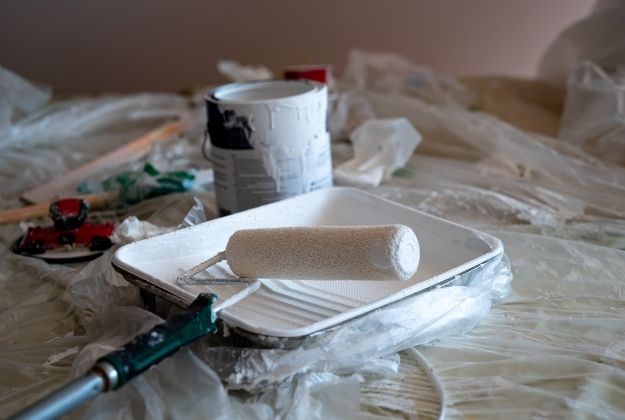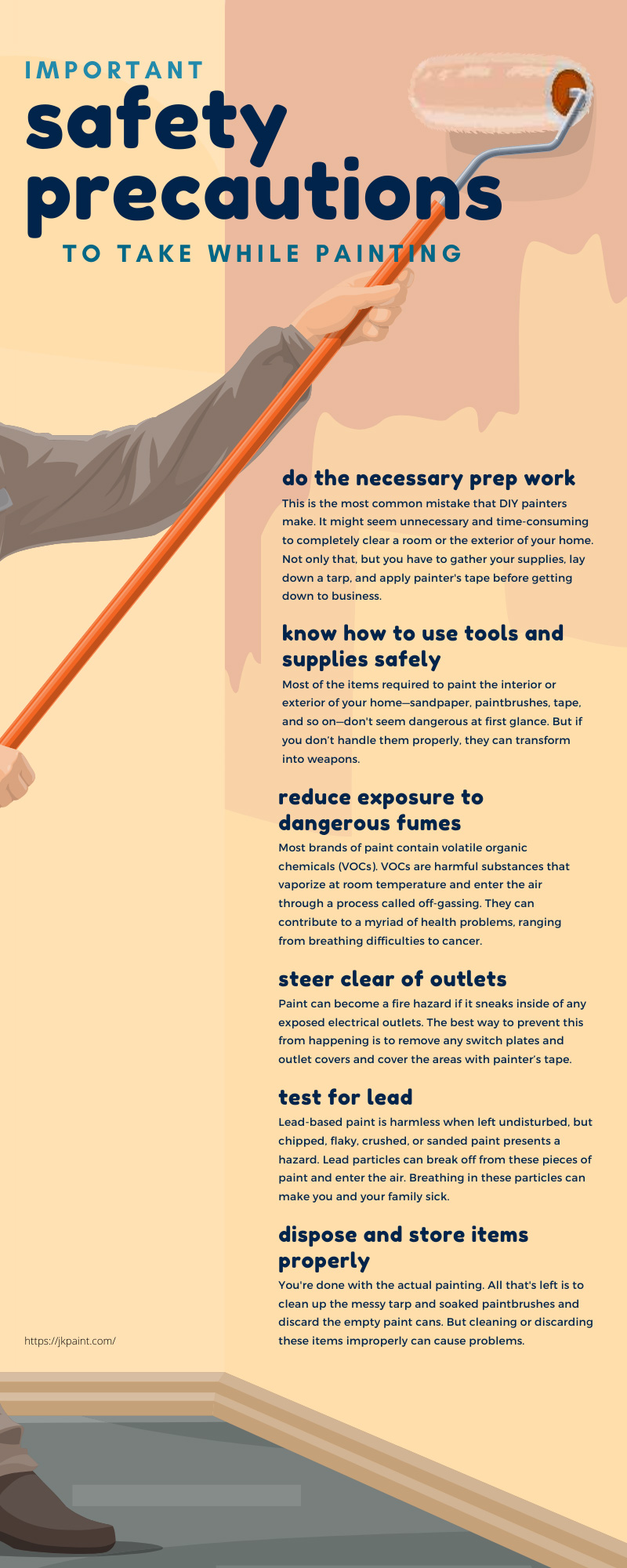
Painting is so simple that most homeowners can do it on their own. But that doesn’t mean you should rush into a painting project headfirst, without taking the time to properly research what you need to do.
It’s not unusual for ambitious DIYers to make clumsy mistakes, or worse—neglect the recommend safety precautions and become ill or injured. Before you grab your brushes and start painting, take the time to familiarize yourself with these important safety precautions to take while painting. Keep yourself protected against lead, chemical fumes, slips and falls, and other common hazards.
Do The Necessary Prep Work
This is the most common mistake that DIY painters make. It might seem unnecessary and time-consuming to completely clear a room or the exterior of your home. Not only that, but you have to gather your supplies, lay down a tarp, and apply painter’s tape before getting down to business. But this step is important if you want to steer clear of preventable injuries.
You don’t want to slip off a ladder and fall onto a rock-hard granite countertop or the roof of your car, nor do you want to trip while you’re walking around with heavy cans of paint. Removing any potential obstacles before you start painting will make the job easier and safer.
Know How To Use Tools and Supplies Safely
Most of the items required to paint the interior or exterior of your home—sandpaper, paintbrushes, tape, and so on—don’t seem dangerous at first glance. But if you don’t handle them properly, they can transform into weapons.
Wildly swinging around a paint-saturated brush without safety goggles can lead to a splotch of paint landing in your eyes. And if you haven’t secured and stabilized your ladder, it can send you plummeting to the ground, sometimes from multiple stories high.
You should always familiarize yourself with how to use the required tools or supplies. When in doubt, parse through the user’s manual or browse through safety tips online. Make sure you wear protective goggles, a dust mask, and work gloves as an extra precaution when painting.
Reduce Exposure To Dangerous Fumes
This is one of the most important safety precautions to take while painting. Always try to reduce your exposure to dangerous fumes. Most brands of paint contain volatile organic chemicals (VOCs). VOCs are harmful substances that vaporize at room temperature and enter the air through a process called off-gassing. They can contribute to a myriad of health problems, ranging from breathing difficulties to cancer.
To keep fumes at bay, ensure you keep the room’s air flowing by opening doors and windows. You can also use an exhaust fan to remove fumes from your workspace. And wearing a mask will help reduce your exposure, too.
Another option is to use low or no-VOC paints—paints that contain a minimal quantity of VOCs. These paints are nontoxic, made from natural materials, and are much better for your health and the environment than solvent-based paints.
Steer Clear of Outlets
Paint can become a fire hazard if it sneaks inside of any exposed electrical outlets. The best way to prevent this from happening is to remove any switch plates and outlet covers and cover the areas with painter’s tape.
If you’re very worried about starting a blaze, you can cut off the room’s power supply before you start. Just remember to stock up on battery-powered light sources to keep the room bright enough for you to see what you’re doing (assuming the room doesn’t have sufficient natural light).
Test for Lead
If your home is on the older side (built before 1978), the existing paint may contain lead. Lead made paint more durable and moisture resistant, but it also made it more dangerous.
Lead-based paint is harmless when left undisturbed, but chipped, flaky, crushed, or sanded paint presents a hazard. Lead particles can break off from these pieces of paint and enter the air. Breathing in these particles can make you and your family sick. Lead is notorious for causing learning disabilities and behavioral problems in children, as well as lead poisoning, anemia, and impaired brain and nervous system functions, among various other serious conditions and symptoms.
You can paint over lead paint—this is called encapsulation. You can apply an encapsulant to lead-based paint to prevent paint chips or dust from coming off. Unfortunately, most forms of conventional paint aren’t considered encapsulants. Additionally, the average homeowner shouldn’t attempt encapsulation on their own.
If you suspect your home has lead-based paint, send in a sample for testing. If the results come back positive, call a professional to remove the paint before progressing with a paint job.
Dispose and Store Items Properly
You’re done with the actual painting. All that’s left is to clean up the messy tarp and soaked paintbrushes and discard the empty paint cans. But cleaning or discarding these items improperly can cause problems.
If you used latex paint, keep in mind that the leftover paint must dry before you can toss it. Depending on how much paint is left in the can, this can take anywhere from a few hours to a few days. You can leave the cans in a well-ventilated area to speed up the process.
But what if you want to keep the leftover paint in case you need to do a touch-up? Or maybe you want to reuse the paint for a future project. In that case, store the cans in a dry room that stays at room temperature year-round. To keep air from entering the container, put the lid back on tightly and flip the cans upside down before storing them.
When it comes to cleaning paint-covered roller brushes, you’ll want to use nontoxic, citrus or turpentine-based cleaners. You can always use regular dish soap or a different cleaner instead, but natural and nontoxic cleaning supplies release fewer fumes and are better for your health.
If you need lead paint removal in Portland, Oregon to ensure your home is safe before the painting starts or reliable and friendly professionals to help you with the painting itself, contact JK Paint and Contracting today!





